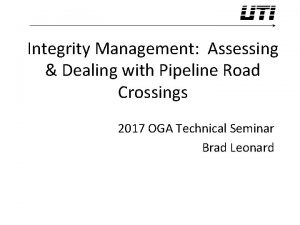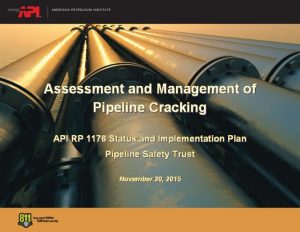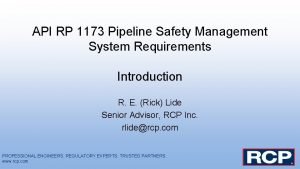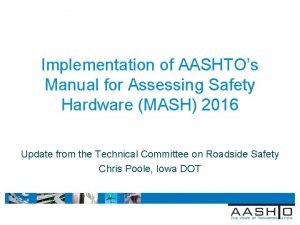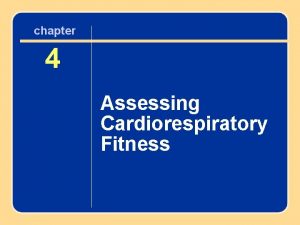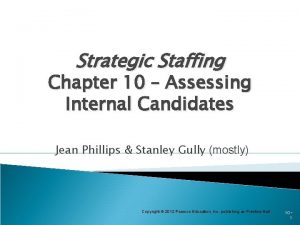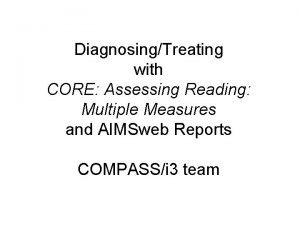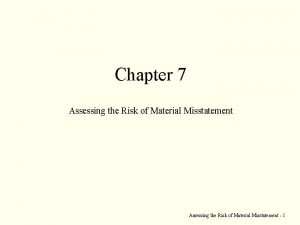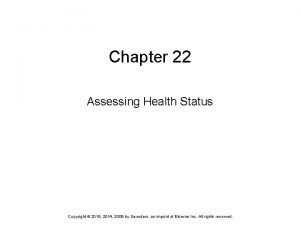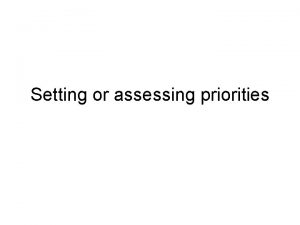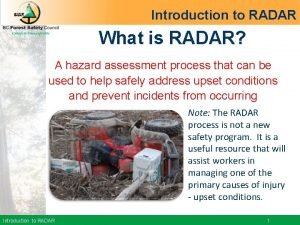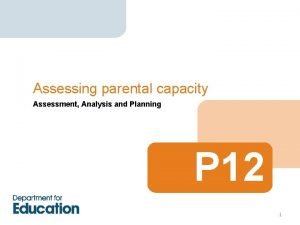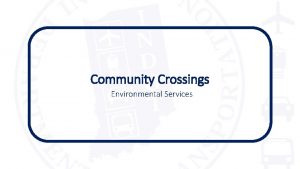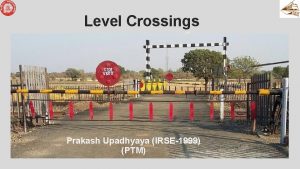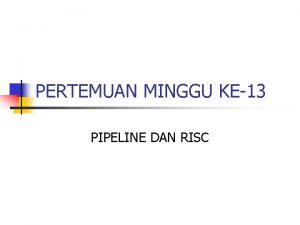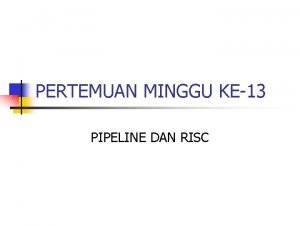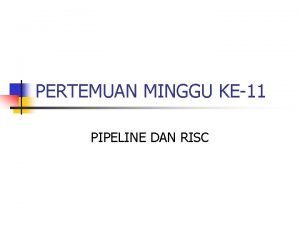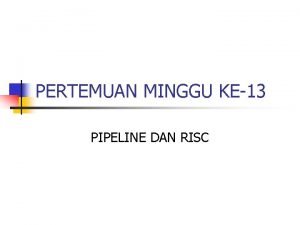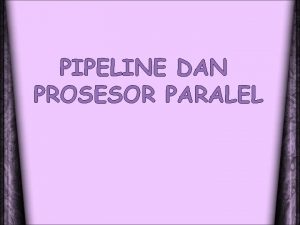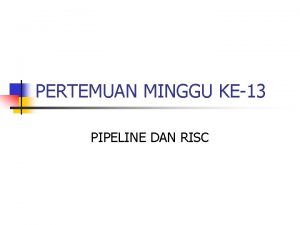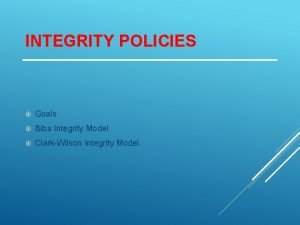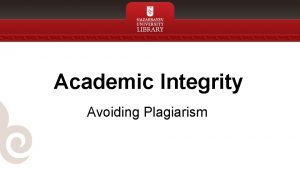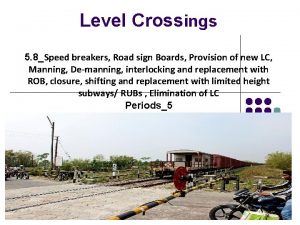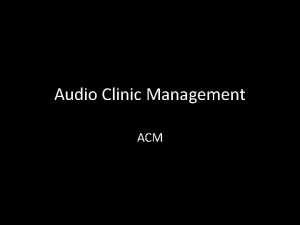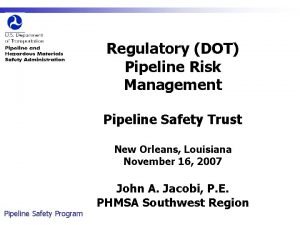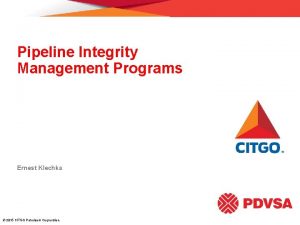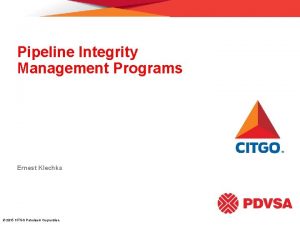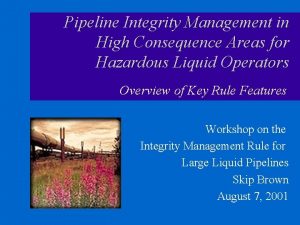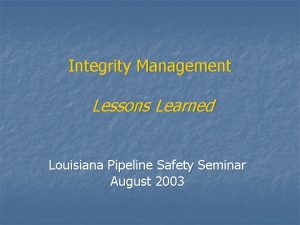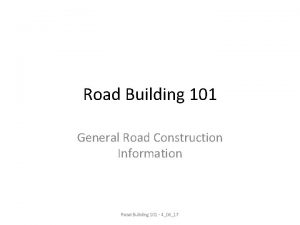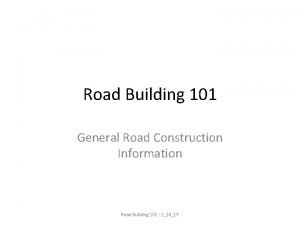Integrity Management Assessing Dealing with Pipeline Road Crossings






































- Slides: 38

Integrity Management: Assessing & Dealing with Pipeline Road Crossings 2017 OGA Technical Seminar Brad Leonard

DISCUSSION FORMAT • Types of Pipeline Installations at Crossings – Problems • Current Technologies used for Integrity Assessments – Pros & Cons • Conclusions – Open Discussion


ROAD CROSSING HISTORY Casing, Heavy Wall Pipe, & Horizontal Directional Drill (HDD) installation began for the following: 1. Potential for stress damage to the pipeline caused from heavy loads, trains and trucks. 2. Unstable soils 3. Corrosion caused by oxygen concentration cells because of road building processes 4. Access Issues (HDD) 5. Ease of removal and replacement of pipelines (casings) 6. Venting of dangerous gasses away from road side (casings)

ISSUES AT CROSSINGS • • Traffic, Population Dense Areas Locating ends of crossings Other Utilities typically share easements High Resistant Overburdens – Depth • Permitting (other easements / issues to consider) • Accessibility to piping • More conducive to corrosion due to road salts and other constituents (i. e. herbicides, insecticides etc…)

HISTORIC CASING PRACTICES • Common Practice started w/ RR Crossings • Highway requirements came later • End Seal Types – Concrete or Enamel w/ Rope – Today: Wraps, Shrink Sleeves and Link Seal types • Spacer Types – – Metallic Concrete coated pipe Wooden Today: Plastics

CASED CROSSING – MAJORITY OF ROAD CROSSINGS IN HCAs NACE SP 0200 -2014 DEFINITIONS • Carrier Pipe: The pipe or piping that is pushed through the casing or sleeve. • Casing: A metallic pipe (normally steel) installed to contain a pipe or piping. • Metallic Short: Direct or indirect metallic contact between two metallic structures. • Electrolytic Contact: Ionic contact between two metallic structures via an electrolyte (water).

NACE SP 0200 - 2014 • 1. 1 Steel casings are used to install and maintain pipeline crossings such as those at road and railroad rights of way. This standard details acceptable practices for the design, fabrication, installation, and maintenance of steel-cased pipelines. • 1. 2 Use of cased crossings should be avoided unless required by load considerations, unstable soil conditions, or when their use is dictated by sound engineering practices. • 1. 3 This standard does not imply that utilization of casings are mandatory or necessary.

NACE SP 0200 - 2014 • 3. 2. 3 Uncoated casing pipe is normally used. The use of coated or nonmetallic casing pipe is not recommended, due to potential shielding problems. • 3. 2. 4 Vent pipes should be installed on both ends of a casing. • 3. 2. 5 The casing vent hole should be at least one-half the diameter of the vent pipe (25 mm [1. 0 in] minimum). The casing vent pipe should be a minimum of 50 mm (2 in) in diameter. • 3. 2. 6 The casing and carrier pipe shall be properly supported for the entire length of the pipe, especially near the ends, to prevent sagging, metallic contact, and to avoid carrier pipe stress. Refer to Paragraphs 4. 3 and 4. 4. • 3. 2. 7 Properly designed casing end seals shall be installed to prevent ingress of water and debris. • Of course this rarely happens!

END SEAL – BOOT TYPE *Note the metal banding

END SEAL – LINK SEAL *Note the metal bolts

SMALL CASING SPACER *Note the metal bolts and the black coated metal

LARGE CASING SPACER *Note the metal

PROBLEMS WITH CASED PIPELINES • Once water enters a casing: – Corrosion can develop – Even if the casing is not electrically shorted, the Cathodic Protection (CP) current may not be enough to adequately protect the pipe. – Any CP current passing through the casing will only provide some protection to that part of the pipe immersed in the water. – No way to properly monitor the CP potentials inside the casing.

PROBLEMS WITH CASED PIPELINES • Corrosion occurs on the external surfaces of pipelines inside casings whether the casing is shorted to the pipe or not! • US Department of Transportation agrees that there almost as many leaks in un-shorted casings as in shorted casings.

CASING SHORTS TO PIPE - CAUSES • End seals crush or deteriorate allowing water to enter • Pipe spacers crush or wrong type used such as metal or metal components • Test leads make contact in the test station • Vent pipes connected to the pipeline or supported on the pipeline • Other possible problems such as metal tools left inside the pipe.

SHORTED CASING Vent Pipe Casing Isolating Spacers A high percentage of shorted casings occur at the ends allowing the pipe to contact the casing causing an electrical (metallic) short.

CURRENT INTEGRITY MANAGEMENT ASSESSMENTS • Pressure Testing – Typically conducted as a hydrostatic or nitrogen test on larger segments of piping, not just road crossing – Modifications to piping for testing – Environmental Concerns, permitting – Removal of pressure test constituents – Disposal of constituents • Inline Inspection – Modifications to piping for launching and receiving tools • Direct Assessment – High Resistance Overburdens – Accessibility to Piping – Crossing more than often cased • Other Technologies – dependent on application utilize

DIRECT ASSESSMENT: The four steps for assessing casings using Direct Assessment Pre-Assessment, Indirect Inspection, Direct Examination, Post Assessment 1. – – – Pre-Assessment Use Historical data to develop a scenario • Coating Type • Quality of Pipe • Water Table • Filled or not • etc… Feasibility for Indirect Inspection – not always conducive Region Identification - for casings can be problematic • PHMSA has developed guidelines (exhibit B of Guidelines for Integrity Assessment of Cased Pipe for Gas Transmission Pipeline in HCA’s rev 0, 2010) for assuring that all casings in a single region are sufficiently similar, as specified in NACE SPO 0502 -2010, while allowing flexibility to allow the grouping of casings into a single region.

DIRECT ASSESSMENT 2. Indirect Inspection – PHMSA Guidelines for Integrity Assessment of Cased Pipe for Gas Transmission Pipelines in HCA’s rev 0 – March 1, 2010 – Methodologies: Exhibit A of Guidelines for guidance on tool selection



23


DIRECT ASSESSMENT 3. Direct Examination – Dig up casing for further inspection problematic – There are various ways to verify condition of pipe • Guided Wave – This method use torsional data as well as compressional wave modes to detect cracks, metal loss and other defects on a carrier pipe inside a casing. • In Line Inspection or Tethered Pigs – ILI is used to determine the presence or absence of pitting-corrosion damage on carrier pipe inside a casing. • Hydrostatic Test (Go-no-Go Type Test) • Video of annulus between pipe and casing (only identifies, no quantification of severity of anomalies)

GUL – SHORTED CASING

WHAT TO DO WHEN THE CASING CAN NOT BE REMOVED 1. Correct shorted casing when possible – Most casings are shorted at the end(s) where the end seals or supports have collapsed. – Inspect the test lead wires. They may be shorted to the vent pipes or to each other. – Make sure vent pipes are not welded to the pipe. – Reposition the pipe and replace the end seals.

WHAT TO DO WHEN THE CASING CAN NOT BE REMOVED OR • Clean and fill the casing with a wax type filler – Make sure vent pipes have sufficient (2”) openings to the inside of the casing in the proper configuration for best fill. – Clean out casing using air, power washer, or suction truck. – Remove old End Seals to assist the cleaning, then replace with new seals. – Pressure Test Seals with minimum 5 psi. In one vent and out the other to ensure quality fill.

PHMSA 192. 467 “Except for unprotected copper inserted in ferrous pipe, each pipeline must be electrically isolated from metallic casings that are a part of the underground system. However, if isolation is not achieved because it is impractical, other measures must be taken to minimize corrosion of the pipeline inside the casing. ” 20

TYPES OF CASING FILLERS 1. Hot applied Wax based materials with corrosion inhibitors 2. Cold Applied Wax based materials with corrosion inhibitors 3. Gels with corrosion inhibitors 4. Inert gas (casing must be sealed to provide positive pressure). Practical? 5. Inject vapor and or water based type inhibitor in annulus. Practical?

REQUIREMENTS FOR FILLING A CASING • • Diameter and length of casing and carrier Location of casing(s) Access to reach vents Preparation of casing including: – Evaluation of vents to be set up in best configuration for successful fill – New End Seals with 170 F temperature rating if using a Hot Wax Casing Filler (Most Shrink Sleeves do not meet the temp requirement) – Air pressure test of 5 psi, no spacer blockage, no vent blockage

CASING FILL PREPARATION Vent Pipe Casing The lower side of the casing should have the opening at the bottom to allow cleaning and placement of casing filler material. Isolating Spacers

CASING FILLERS • The majority of Casing Fillers are a blend of petroleum wax and corrosion inhibitors. These hot materials are pumped into the casings by custom, heated trucks with meter controls and experienced personnel. • Cold Applied Casing fillers come in barrels and use a mastic pump for installation. This system is good for smaller projects utilizing in -house labor.

INSTALLATION OF NEW CASING AND PIPE • Do not install casing unless absolutely necessary. • If installation is required, be sure to install properly coated pipe with enough supports to keep the pipe separate from the casing. • Insure the end seals are properly installed. • Attach vent pipes of proper size and location to provide installation of casing filler. • Using fillers within annulus of cased piping doesn’t allow for the use of continual Indirect Inspection methodologies.

Direct Assessment 3. Post Assessment – No current guidelines via PHMSA other than encouragement for operators to consider a rigorous implementation of a post assessment process similar to that utilized for mainline piping as prescribed in NACE SP 0502 -2010. – PHMSA expects operators to have and maintain a strong DA effectiveness strategy – Continual improvement of DA program for cased pipe as operators learn more about their systems and as the industry develops improving technologies

CONCLUSIONS All pipeline road crossings are a problematic. Data and frequency of data collection are necessary for monitoring Remove casings when possible, shorted or not. When you must install a new casing, collect baseline indirect inspection data as a milestone • Corrosion occurs almost as often in non-shorted casings as in shorted casings. • Water is present in nearly all casings • Filling a casing will remove the electrolyte / water from the equation and stop any further corrosion but limits future monitoring via indirect inspection techniques for future assessments • •


TOTAL CAPABILITIES IN THE PIPELINE INDUSTRY QUESTIONS? UTILITY TECHNOLOGIES INTERNATIONAL CORPORATION www. uti-corp. com
 Road crossing pipe sleeve detail
Road crossing pipe sleeve detail Difference between linear and nonlinear pipeline processors
Difference between linear and nonlinear pipeline processors Scalar pipeline
Scalar pipeline Api rp 1160
Api rp 1160 An uncontrolled railroad crossing
An uncontrolled railroad crossing Chapter 7 negotiating intersections
Chapter 7 negotiating intersections Points and crossings
Points and crossings An uncontrolled railroad crossing usually has
An uncontrolled railroad crossing usually has What is paved and unpaved road
What is paved and unpaved road Dealing with competition marketing management
Dealing with competition marketing management Dealing with competition marketing management
Dealing with competition marketing management Api 1173 pipeline safety management systems
Api 1173 pipeline safety management systems Pipeline control room software
Pipeline control room software Assessing risk in sport regulatory bodies
Assessing risk in sport regulatory bodies Unit 18 assessing children's development support needs
Unit 18 assessing children's development support needs Teaching and assessing grammar in the writing classroom
Teaching and assessing grammar in the writing classroom What are the domains of ppst
What are the domains of ppst Assessing need for hrd
Assessing need for hrd Informal reading inventory strengths and weaknesses
Informal reading inventory strengths and weaknesses Manual for assessing safety hardware
Manual for assessing safety hardware Chapter 4 cultural dynamics in assessing global markets
Chapter 4 cultural dynamics in assessing global markets Assessing a new venture's financial strength and viability
Assessing a new venture's financial strength and viability Assessing cardiorespiratory fitness
Assessing cardiorespiratory fitness Assessing leadership and measuring its effects
Assessing leadership and measuring its effects Module 4 topic 1 assessing and managing risk
Module 4 topic 1 assessing and managing risk Module 4 topic 1 assessing and managing risk
Module 4 topic 1 assessing and managing risk A nine box matrix requires assessing employees on ________.
A nine box matrix requires assessing employees on ________. Oecd maps
Oecd maps Core assessing reading multiple measures
Core assessing reading multiple measures Acceptable audit risk
Acceptable audit risk Assessing math concepts
Assessing math concepts Chapter 22 assessing health status
Chapter 22 assessing health status Assessing motivation to change
Assessing motivation to change Assessing opportunity cost involves
Assessing opportunity cost involves Hazard communication quiz answers
Hazard communication quiz answers Cultural dynamics in assessing global markets
Cultural dynamics in assessing global markets Assessing value for money
Assessing value for money Assessing parental capacity
Assessing parental capacity Group discussion
Group discussion
